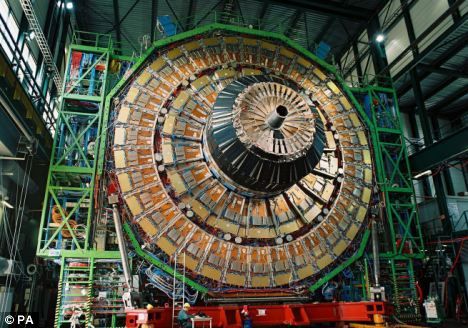The experimental data of the Large Hadron Collider is converted to sound for the first time
For the first time, scientists of the Large Hadron Collider project converted the massive data generated by this collider into sound. This is what they think the Higgs boson data show

The Large Hadron Collider is located in a circular tunnel 100 meters deep and 27 kilometers long on the border between France and Switzerland. It is processing data at a rate of 40 million times per second.
Sina Technology News, Beijing time, January 5 news, the European Large Hadron Collider (LHC) project scientists for the first time converted the massive data generated by this collider into sound.
The Large Hadron Collider at the European Nuclear Research Center (CERN) is currently the world ’s largest and highest-energy particle accelerator, seeking to prove the existence of mysterious particles like the Higgs boson, processed at 40 million times per second data. Researchers believe that the Higgs boson is the source of mass in the universe. Prior to this, the Large Hadron Collider output data in the form of color images. This is when it shoots colored particles in different directions.
However, Dr. Lily Asquith, a physicist who recently worked on the Large Hadron Collider project, hopes to hear the sound of the particles produced by the experiment. So, she used music comparison software to convert the data generated by the Large Hadron Collider into sound, thereby giving the robot a side. The construction of the Large Hadron Collider began in 2003 and is located in a ring tunnel 100 meters deep and 17 miles (27 kilometers) long under the French-Swiss border.
Asquis said in an interview with the radio station NPR: "Everyone likes to make thought-provoking things human. I personally think that electronics may sound like a carillon. We naturally think that some sounds may be related to These things are connected. "In this attempt, Dr. Asquith entered data samples (three sets of data) of the Large Hadron Collider into the music comparison software.
When the particle beam is launched into the Large Hadron Collider, three data points are collected and added to the sound parameters: particles away from the internal beam become the tone of the sound, the energy of the particles is converted into volume, and the tune The length of time shows the particle travel distance. Asquis explained: "For example, we will draw the first set of numbers for time-perhaps distance. We will also draw the second set of numbers-tone, and the third set of numbers-volume."
Although the resulting sounds may not be called music, they are certainly attractive to trendy music fans. Asquis admitted that scientists cannot learn much from these voices at present, but she hopes that they will soon give scientists new insights into the data of the Large Hadron Collider. Because the Large Hadron Collider can generate new data about the origin of the universe so quickly, physicists may extend the current "Big Bang" simulation experiment to the end of 2012.
As a result, they may discover the mysterious Higgs boson in advance. Scientists believe that at the beginning of the birth of the universe, the Higgs boson turned solid particles into particles that had not yet been shaped. The Large Hadron Collider was officially launched two years ago and attracted worldwide attention. However, due to a malfunction, it was forced to shut down after two weeks of operation. According to the design, the Large Hadron Collider can simulate the state after the formation of the universe and identify various mysterious particles, thus filling the gap in the field of physics research.
It started with collision experiments with protons—positively charged particles found in the nucleus. In November 2010, it began to strike lead ions in an attempt to understand the "quark-gluon plasma" that filled the universe instantly after the Big Bang. A large heavy ion experimental detector (ALICE) weighing 10,000 tons created a "mini-big bang" in the tunnel. Powerful magnets drive lead ions to run at high speeds in underground tunnels at a speed close to the speed of light. Lead ions operate in two opposite directions, and finally the focus becomes a narrow and long beam, which is forced to collide in a large heavy ion experimental detector.
Before the European Nuclear Research Center, Brookhaven National Laboratory, a US Department of Energy, used the relativistic heavy ion collider (RHIC) to create quark gluon plasma by hitting gold ions. However, this collider can only produce high temperatures of 4 million degrees Celsius. Scientists hope that through quarks and gluon plasmas, they can learn more about strong forces. Strong force is one of the four basic forces in nature. (Qiu Ling)
Giant 4 In A Row,Giant Four In A Row,Giant 4 In A Row Game,Giant Four In A Row Game
Ningbo Gibbon Sports Culture Co.,Ltd , https://www.gibbonsports.com